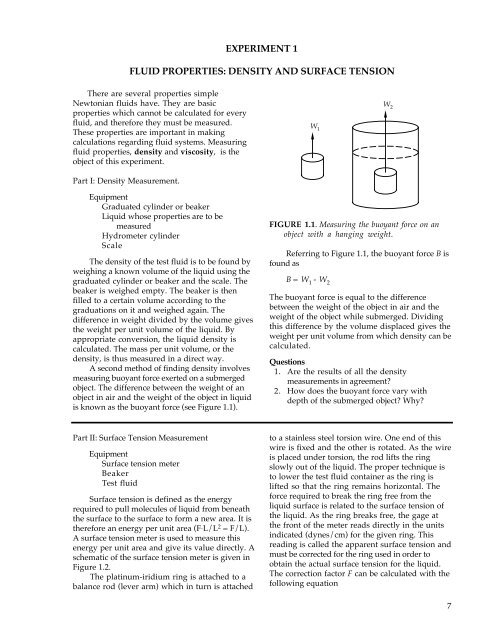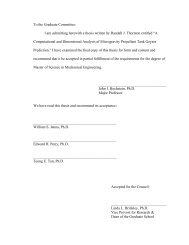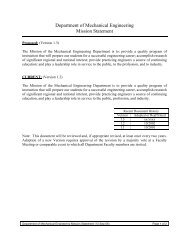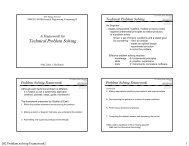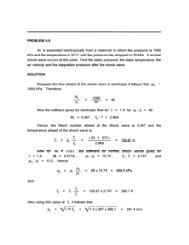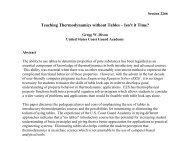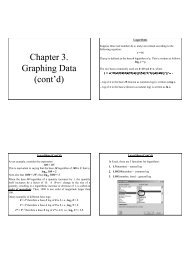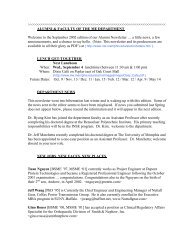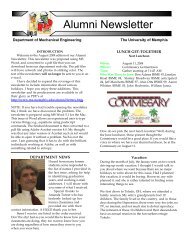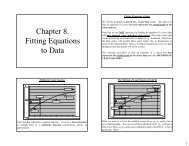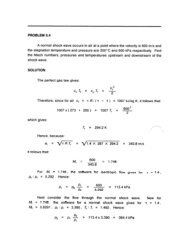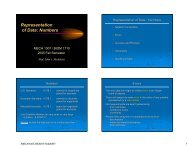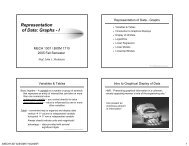MECHANICS of FLUIDS LABORATORY - Mechanical Engineering
MECHANICS of FLUIDS LABORATORY - Mechanical Engineering
MECHANICS of FLUIDS LABORATORY - Mechanical Engineering
You also want an ePaper? Increase the reach of your titles
YUMPU automatically turns print PDFs into web optimized ePapers that Google loves.
EXPERIMENT 1<br />
FLUID PROPERTIES: DENSITY AND SURFACE TENSION<br />
There are several properties simple<br />
Newtonian fluids have. They are basic<br />
properties which cannot be calculated for every<br />
fluid, and therefore they must be measured.<br />
These properties are important in making<br />
calculations regarding fluid systems. Measuring<br />
fluid properties, density and viscosity, is the<br />
object <strong>of</strong> this experiment.<br />
W 1<br />
W 2<br />
Part I: Density Measurement.<br />
Equipment<br />
Graduated cylinder or beaker<br />
Liquid whose properties are to be<br />
measured<br />
Hydrometer cylinder<br />
Scale<br />
The density <strong>of</strong> the test fluid is to be found by<br />
weighing a known volume <strong>of</strong> the liquid using the<br />
graduated cylinder or beaker and the scale. The<br />
beaker is weighed empty. The beaker is then<br />
filled to a certain volume according to the<br />
graduations on it and weighed again. The<br />
difference in weight divided by the volume gives<br />
the weight per unit volume <strong>of</strong> the liquid. By<br />
appropriate conversion, the liquid density is<br />
calculated. The mass per unit volume, or the<br />
density, is thus measured in a direct way.<br />
A second method <strong>of</strong> finding density involves<br />
measuring buoyant force exerted on a submerged<br />
object. The difference between the weight <strong>of</strong> an<br />
object in air and the weight <strong>of</strong> the object in liquid<br />
is known as the buoyant force (see Figure 1.1).<br />
FIGURE 1.1. Measuring the buoyant force on an<br />
object with a hanging weight.<br />
Referring to Figure 1.1, the buoyant force B is<br />
found as<br />
B = W 1<br />
- W 2<br />
The buoyant force is equal to the difference<br />
between the weight <strong>of</strong> the object in air and the<br />
weight <strong>of</strong> the object while submerged. Dividing<br />
this difference by the volume displaced gives the<br />
weight per unit volume from which density can be<br />
calculated.<br />
Questions<br />
1. Are the results <strong>of</strong> all the density<br />
measurements in agreement?<br />
2. How does the buoyant force vary with<br />
depth <strong>of</strong> the submerged object? Why?<br />
Part II: Surface Tension Measurement<br />
Equipment<br />
Surface tension meter<br />
Beaker<br />
Test fluid<br />
Surface tension is defined as the energy<br />
required to pull molecules <strong>of</strong> liquid from beneath<br />
the surface to the surface to form a new area. It is<br />
therefore an energy per unit area (F⋅L/L 2 = F/L).<br />
A surface tension meter is used to measure this<br />
energy per unit area and give its value directly. A<br />
schematic <strong>of</strong> the surface tension meter is given in<br />
Figure 1.2.<br />
The platinum-iridium ring is attached to a<br />
balance rod (lever arm) which in turn is attached<br />
to a stainless steel torsion wire. One end <strong>of</strong> this<br />
wire is fixed and the other is rotated. As the wire<br />
is placed under torsion, the rod lifts the ring<br />
slowly out <strong>of</strong> the liquid. The proper technique is<br />
to lower the test fluid container as the ring is<br />
lifted so that the ring remains horizontal. The<br />
force required to break the ring free from the<br />
liquid surface is related to the surface tension <strong>of</strong><br />
the liquid. As the ring breaks free, the gage at<br />
the front <strong>of</strong> the meter reads directly in the units<br />
indicated (dynes/cm) for the given ring. This<br />
reading is called the apparent surface tension and<br />
must be corrected for the ring used in order to<br />
obtain the actual surface tension for the liquid.<br />
The correction factor F can be calculated with the<br />
following equation<br />
7


